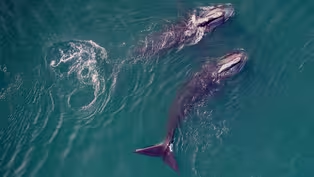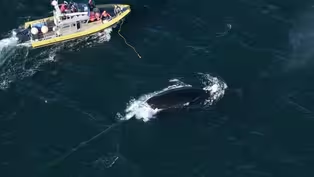
Meet Snow Cone the Right Whale and Her Calf
Clip: Season 50 Episode 7 | 4m 32sVideo has Closed Captions
Since 2010, the average time between North Atlantic right whale births has increased.
In 2020, the number of North Atlantic right whale calves born in the Southeast was slightly higher than it had been in previous years, but still nowhere near enough to get the population moving in a positive direction.
Problems playing video? | Closed Captioning Feedback
Problems playing video? | Closed Captioning Feedback
Additional funding is provided by the NOVA Science Trust with support from Margaret and Will Hearst and Produced with the Financial Participation of Telefilm Canada, Produced with the Participation of...

Meet Snow Cone the Right Whale and Her Calf
Clip: Season 50 Episode 7 | 4m 32sVideo has Closed Captions
In 2020, the number of North Atlantic right whale calves born in the Southeast was slightly higher than it had been in previous years, but still nowhere near enough to get the population moving in a positive direction.
Problems playing video? | Closed Captioning Feedback
How to Watch NOVA
NOVA is available to stream on pbs.org and the free PBS App, available on iPhone, Apple TV, Android TV, Android smartphones, Amazon Fire TV, Amazon Fire Tablet, Roku, Samsung Smart TV, and Vizio.
Buy Now

NOVA Labs
NOVA Labs is a free digital platform that engages teens and lifelong learners in games and interactives that foster authentic scientific exploration. Participants take part in real-world investigations by visualizing, analyzing, and playing with the same data that scientists use.Providing Support for PBS.org
Learn Moreabout PBS online sponsorship- [Narrator] Barb Zoodsma coordinates NOAA's Right Whale Recovery Program in the Southeast.
In February 2020, she heads out to look for new calves with biologist Tom Pitchford.
- [Plane Operator] Harvey, Orion mostly at the surface and traveling in the northwest direction slowly, over.
- Perfect, we're all set.
Thank you very much.
The plane just radioed us and they said there is an Alpha Charlie over here, and that's code for an adult and calf.
As a protection measure, we're kind of cryptic on the radio.
Katie, will you let me know when you have eyes on them?
- Will do.
- Thank you.
The right whale count of calves born thus far in the Southeast, and that's all of the Southeast, United States, is at 10.
It's better than the seven last year and two years ago when there was zero.
It's nowhere near enough to get the population moving in a positive direction.
- Our average calving interval was three to five years for a long time, and what we've been seeing since 2010 is that just creep up and up and up and up.
And so we're into this seven, eight, nine, 10-year tagging interval for a lot of females.
- All right.
I'm moving in a little bit slower.
(lively music) Look how smooth it is.
Those calves are very weak swimmers when they're first born, and so these are real good conditions for the calves to learn how to swim.
When they leave here, they have hundreds of miles to swim.
They're gonna need a really strong bond to make it there together.
(lively music) - [Narrator] The whales can't stay in these calm, warm waters for long.
The mothers need to eat huge quantities of food in the spring and summer to survive.
And so by March, the pairs head north to the plankton-rich waters off New England and Canada.
The calves will nurse for at least 10 months and more than double in size before they learn to find food.
Most calves stay with their mothers for about 12 months before venturing out on their own.
(lively music) - In Florida, we work closely with groups of citizen scientists who are extending the reach of our airplane by going to the beach and scanning the ocean for right whales.
And it can be a huge help.
- [Narrator] This is Lily Pinkham's first year volunteering with the Marineland Right Whale Project.
- The first thing I saw was a spout.
As time went on and I started putting it out to everybody, it started putting its flippers up and then we saw that there were two spouts.
And we were able to identify it as a right whale because of the V-shaped blow.
- So because that was a big one.
But the first sighting, that was all due to Lily.
- The first sighting that was due to our team.
Yeah, that's right.
- [Narrator] The first calf sighted in the 2020 season was born to a 15-year-old first-time mother.
This is female 3560, named Snow Cone, with her baby.
(water splashing) (whale grunting) We won't be able to identify this calf based on just what callosities we see now, but they darted this calf, too, so they have DNA, which will help identify him later.
And look, the calf's upside down, you see both of the pectoral fins.
- [Citizen Scientist] Oh, my gosh.
(scientists chuckling) - [Narrator] As right whales mature, roughened patches of skin, like callouses, form on their heads.
This pattern is unique, like a fingerprint, and helps scientists identify and keep track of individual whales, over the years.
- She's now been seen off Miami and possibly the Keys; they're trying to confirm that.
- [Citizen Scientist] This year?
- Yeah, right now, right now.
But, generally, it's just unusual behavior for any of the right whales to go south of Canaveral.
So 3560 is going to keep us guessing for a while.
(tranquil music) (water splashing) And so the question is will she turn around and come back or will she go into the Gulf of Mexico?
(tranquil music) (water splashing)
Saving the Right Whale Preview
Video has Closed Captions
Preview: S50 Ep7 | 27s | Follow scientists determined to save the critically endangered right whale. (27s)
Scientists Attempt To Free Entangled Right Whale
Video has Closed Captions
Clip: S50 Ep7 | 3m 30s | Entanglement responders work to free a critically endangered whale from rope. (3m 30s)
Providing Support for PBS.org
Learn Moreabout PBS online sponsorship
- Science and Nature

Capturing the splendor of the natural world, from the African plains to the Antarctic ice.













Support for PBS provided by:
Additional funding is provided by the NOVA Science Trust with support from Margaret and Will Hearst and Produced with the Financial Participation of Telefilm Canada, Produced with the Participation of...




